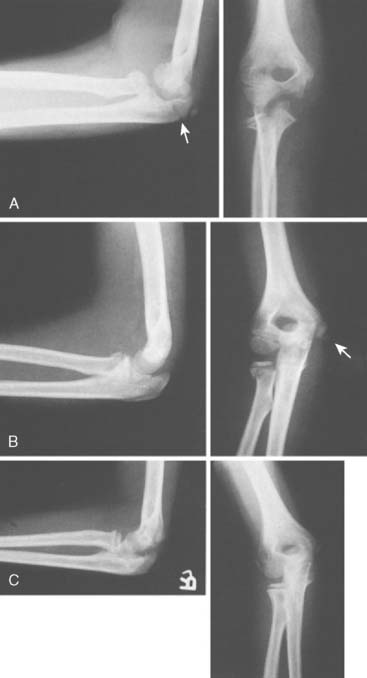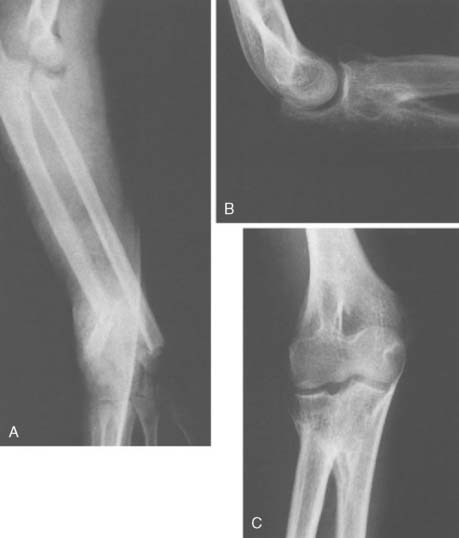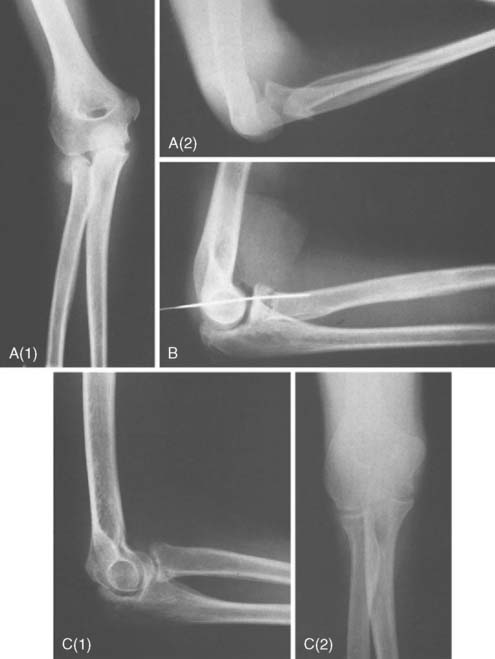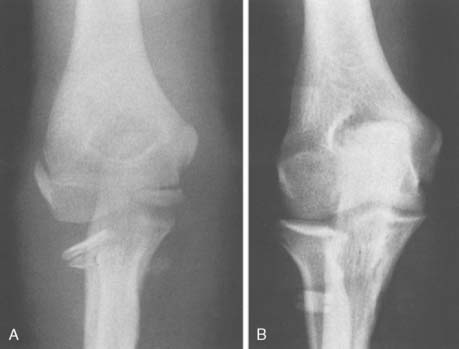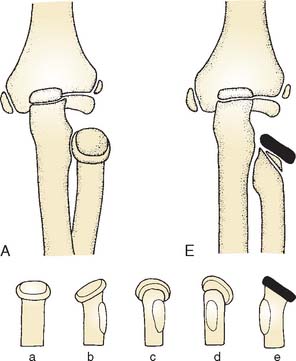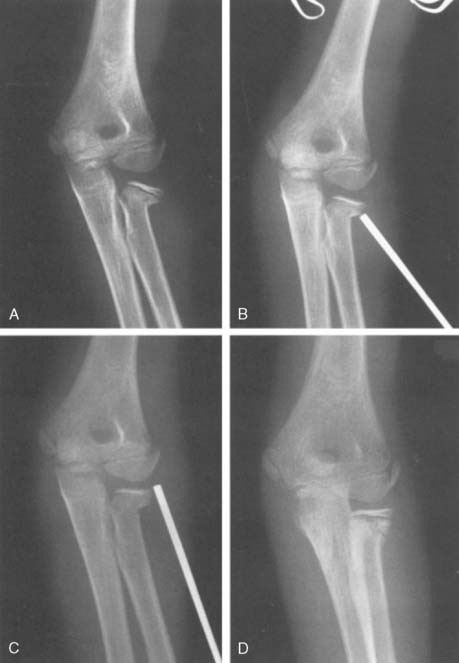CHAPTER 17 Fractures of the Neck of the Radius in Children
INTRODUCTION
Fractures of the neck and head of the radius in children are relatively uncommon, constituting 4% to 7% of elbow fractures and dislocations.2,6,14,16,21,24 A review of the early literature reveals considerable controversy on the significance, treatment, and late results of this injury.12,23,24 However, as is explained in the body of this chapter, since the last edition of this text there has been a growing body of evidence indicating that open reduction and internal fixation should be avoided whenever possible, and that percutaneous reduction (and fixation if necessary) is much more likely to result in a favorable outcome.
Sex frequency varies from series to series, but overall, there seems to be a slight female preponderance. The typical patient age range for radial neck fractures is between 4 and 14 years, with a mean age between 10 and 12 years. Approximately 30% to 50% of patients have associated injuries to the elbow region (Figs. 17-1 and 17-2).10,18,32,39
The prognosis after this fracture seems to depend more on the severity of the injury, the associated injuries about the elbow, and the type of treatment than on the accuracy of the reduction.10,16,23,25 Although emphasis has been placed on the angulation of the radial head, it is actually the displacement of the fracture that is the more important component of the deformity.
The classic discussion on this subject was published by Jeffery,10 whose observations in 1950 clarified the nature of the fracture, the mechanism of injury, the radiologic assessment, the method of reduction, and the prognosis. Complete remodeling of a fracture was demonstrated with perfect function after a residual angulation of 50 degrees.
Closed reduction consistently produces better results than open reduction, even taking into account that more severe injuries are more likely to require operation.23,25 Recently, significant technical advances have been made, making possible the percutaneous reduction of even severely displaced or angulated fractures.1,8,20,31,34
MECHANISM OF THE FRACTURE
A fall on the outstretched arm produces a valgus thrust on the elbow that fractures the radial neck and often avulses structures on the medial side of the joint. The radial head tilts laterally because the forearm is usually supinated, but the exact direction of the tilt depends on the rotational position of the forearm at impact. This is the most common mechanism, but the fracture can also occur with posterior dislocation of the elbow, resulting in two types of displacement, depending on whether the radial head fractures during spontaneous reduction or in the course of dislocating. The first type of fracture10,11 (reduction injury) leaves the separated proximal radial epiphysis tilted 90 degrees posteriorly beneath the capitellum of the humerus (Figs. 17-3 and 17-4). This mechanism of injury has been confirmed in a report of an iatrogenic radial neck fracture that occurred during closed reduction of a posterior elbow dislocation.36 With the second type of fracture23 (dislocation injury), axial compression on the elbow results in anterior displacement of the radial head as the proximal radial epiphysis moving posteriorly is obstructed by the capitellum and fractures in the process (see Fig. 17-2). Less common injuries include anterior dislocation of the head of the radius with associated fracture of the radial neck; Montaggia equilavent injuries28; shear fracture through the neck of the radius with medial displacement of the shaft, which may become locked medial to the coronoid process of the ulna17; and osteochondral fracture of the epiphysis with an intra-articular loose body.
Associated injuries occasionally occurring with radial neck fracture include fracture of the olecranon, avulsion of the medial epicondyle of the humerus, dislocation of the elbow, and avulsion of the medial collateral ligament from the distal humerus.10 Associated injuries are not only important in themselves but also have implications for prognosis and treatment of the radial neck fracture (see Figs. 17-1 and 17-2).16,39
CLASSIFICATION
The fracture may be classified by the degree of angulation of the radial head,24,26 the mechanism of injury,10 the type of epiphyseal plate disruption,26,29 the amount of fracture displacement, or combinations of these.23 O’Brien24 divided these fractures into three groups according to the degree of angulation:
Type III: More than 60 degrees
It is important to recognize that the neck of the radius normally subtends an angle of 165 to 170 degrees with the shaft (see Chapter 2). The radius is not a straight bone, even in its proximal third.16,33 Thus, a measured angulation of 50 degrees may in reality represent only 35 to 40 degrees of true angulation. As in many pediatric injuries, comparison with the uninjured elbow is often helpful, or even essential, for accurate assessment of this feature.
The injury also may be classified according to the type of epiphyseal plate injury. Although some authors believe that the fracture may occur entirely through the metaphysis of the neck of the radius,12,38 this is unusual, both in the literature23 and in our experience.39
Type I: Rare and usually associated with dislocation of the radial head or elbow
Type II: The most common pattern of fracture through the neck of the radius
Type IV: Second in frequency39 and associated with a poor prognosis owing to marked displacement, irregularity of the radial head, and occasional radioulnar synostosis (Figs. 17-5 and 17-6)
We prefer the classification of Wilkins,27 which combines those of Jeffery10 and Newman.23 It is based primarily on the mechanism of injury, but it also describes the deformity to be corrected and suggests the severity of the injury and thus helps in formulating the prognosis.
TREATMENT
ASSESSMENT OF INJURY
The entire extremity should be thoroughly examined for open wounds, other injuries, and neurovascular impairment. A fall on the outstretched hand can result in injury at multiple levels. As in adults, injury about the wrist must be specifically excluded, and fracture of the scaphoid has been reported.10,11
The precise degree of angulation can be accurately determined only by an anteroposterior radiograph with the forearm in the position of rotation at the moment of impact. Jeffery10 demonstrated that this is best achieved by taking radiographs in varying degrees of forearm rotation so that the radial head will cast shadows of different shapes. When the radial head forms as nearly perfect a rectangle as possible, the real degree of angulation can be determined. Oval shapes indicate that the radiographs have not been taken at a right angle to the plane of maximal angulation (Fig. 17-7). Although ob-taining these multiple views is not practical or necessary for the majority of fractures, in cases in which it is unclear whether or not fracture reduction is indicated, performing multiple radiographs as described can be very helpful. Comparison views of the uninjured forearm in the same degree of rotation are helpful in assessing the degree of angulation. Also, in children, normal variations in the radiographic appearance of the proximal radius must be considered when assessing injury.30 Again it is a basic principle of treating elbow fractures in children that radiographs of the injury may be compared with films of the opposite (uninjured) side.
INDICATIONS FOR REDUCTION
It is generally agreed that a radial neck fracture with angulation of more than 60 degrees or more than 3 mm of displacement will likely produce problems if it is not corrected.2,6,23,24,39 It is also agreed that in radial neck fractures, less than 30 degrees’ angulation can safely be accepted,10,25,33 and there is some support for the position that fractures less than 45 degrees’ angulation do not require open reduction.2,23,24,32,35,39 The proper treatment approach should be individualized based on the clinical circumstances of each patient when angulation is between 30 and 60 degrees. There is support both for and against open reduction of these fractures.6,18,25,26,32,39 Advocates of open reduction believe that, without it, significant loss of forearm rotation will ensue. Those who prefer closed reduction or acceptance of deformity believe that the complications of open reduction do not justify the risks, considering the minimal disability that is the legacy of fractures left with even 50 to 55 degrees of angulation.
Recently, two techniques have been developed that provide the benefits of improved fracture alignment yet have not caused the problems associated with open reduction. In several series, percutaneous reduction of radial neck fractures has been associated with fewer complications and less elbow stiffness as compared with open reduction (Fig. 17-8).1,20,31 Originally described using a Steinmann pin, we have also used a small elevator to percutaneously reduce the fracture with excellent success. After percutaneous reduction, fracture stability should be assessed by bringing the elbow through full range of motion including pronation and supination under fluoroscopic imaging. Frequently, the fracture is stable enough that internal fixation is not necessary and casting alone is sufficient. In situations in which redisplacement or angulation occurs, percutaneous pinning or intramedullary stabilization using the Metaizeau technique may be employed.
Stay updated, free articles. Join our Telegram channel

Full access? Get Clinical Tree


